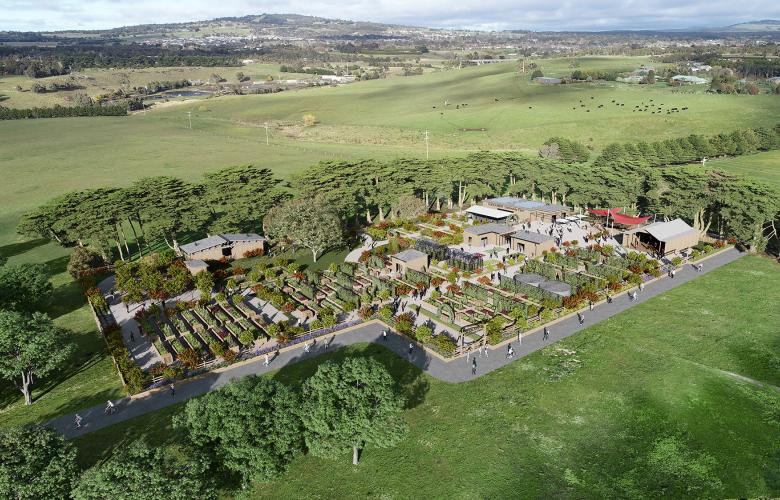Planners must avoid ‘suburbanisation’ of regional towns – community involvement is key says Hatch RobertsDay
Contact
Planners must avoid ‘suburbanisation’ of regional towns – community involvement is key says Hatch RobertsDay
One of Australia’s leading urban planners warns that population growth risks regional areas expanding in the form of conventional suburban subdivisions to facilitate the growth. He provides some insights as to how towns might retain their heritage, character and unique features – and continue to be loved by regional communities – even as they evolve and cater for new arrivals. Mike Day a partner at award-winning Australian urban planning and design practice Hatch RobertsDay.
Population numbers across Australia’s regional cities and towns are expected to grow further as the work-from-home trend and affordable housing is seeing more residents leave the metropolitan cities. One of Australia’s leading urban planners warns that population growth risks regional areas expanding in the form of conventional suburban subdivisions to facilitate the growth. He provides some insights as to how towns might retain their heritage, character and unique features – and continue to be loved by regional communities – even as they evolve and cater for new arrivals.
Between January to September 2020, nearly 64,000 capital cities residents migrated internally.[1]
Mike Day – a partner at award-winning Australian urban planning and design practice Hatch RobertsDay (robertsday.com.au) – predicts an increase in regional town movement will continue in 2021 and beyond.
He says: “Regional towns are accommodating the sea- and tree-changers as more Australians are attracted to improved work-life balance, lower living costs, access to open spaces, nature and a slower pace of life in regional areas. Many find they don’t need to live near metropolitan city centres and pay high living and comuting costs if they can work remotely. This will require our regional towns to cater for the increased demand. Developers and planners must ensure they maintain the character and sense of place in these towns and villages, or face local community backlash and lose the essence of what makes those towns so attractive in the first place. We cannot develop these areas in the same way as new suburbs on the outskirts of our metropolitan cities.”
Through Hatch RobertsDay’s extensive observation of, and work in, regional areas, Mike says it is common for planning approval for projects to be refused or heavily amended when community resistance is high. “Regional residents are closely connected to their towns and are sensitive to change. These towns are often characterised by heritage buildings, compact mini main streets, large open spaces and gardens, and low-density housing – and residents want to maintain these aspects that make the town special in the first place. For this reason, there is nearly always more pushback from regional communities than in new suburbs, which is why it is essential to seek community input early in any planning and development process.”
Mike Day recommends six planning actions for councils, developers and planners to ensure regional township projects are embraced by the community:
1. Councils could develop building codes and guidelines which reflect and respect their distinctive local settings. Mike says developers and planners should respect a town’s character by integrating complementary developments into the existing urban pattern rather than introducing conventional suburban subdivision patterns and built form.
2. Engage and consult early with the community. Local residents are inevitably ‘local experts’ that have travelled extensively. When they are involved early in the planning process they can provide feedback and advise the changes they want to see to create a town they are proud of and will love to continue calling home. Councils and planners can get meaningful input from the community through engaging with residents, planning design forums where the community and stakeholders explore solutions and design ideas through interactive workshops, and social media. By capturing residents’ feedback, designers and planners can ensure the community’s views are reflected in the design and development of any future projects.
3. Create jobs for the local community. Creation of mixed-use neighbourhoods or business hubs and Government projects will attract business and work opportunities for local residents. In Mike’s extensive experience on regional projects, he has found residents are very receptive to development plans that provide local jobs, particularly for the youth of a community, which invariably assists in addressing many social issues.
4. Reinforce and expand existing walkable neighbourhoods. Compact, mixed-use, walkable neighbourhoods provide opportunities for social connection and a reduced reliance on cars. With remote working becoming more popular, living in closer proximity to local amenities can reduce feelings of isolation and loneliness, and will also foster a stronger community and sense of belonging, particularly among new residents moving from major cities.
5. Provide housing diversity. Communities that combine single dwelling homes, townhouses, apartments, and specialised housing such as seniors housing integrated with the township, enables ageing in place and attracts residents of all ages and incomes. Regional communities are receptive to diverse housing options if they maintain the essence and unique character of their townships.
6. Maintain community engagement in perpetuity. Mike says councils, planners and developers must get feedback from the community at all stages of planning and development. Interactive mapping and community forums provide locals with the opportunity to voice their opinions and achieve built form outcomes they feel meet local needs. Mike highlights the importance of getting a true cross-section of the community, not just the vocal minority, through expressions of interest for community involvement. Ongoing community input on regional projects will ensure the critical attributes of the town is retained.








